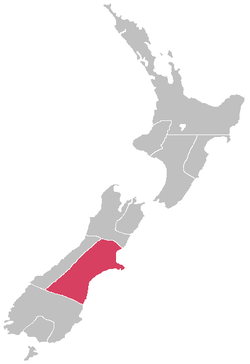Canterbury Province
Canterbury | |
|---|---|
 Canterbury Province within New Zealand post 1868 | |
| Country | New Zealand |
| Island | South Island |
| Established | 1853 |
| Abolished | 1876 |
| Named for | Canterbury, England |
| Seat | Christchurch |
The Canterbury Province was a province of New Zealand from 1853 until the abolition of provincial government in 1876.
Description
The capital of the Province of Canterbury was Christchurch and it was there the Provincial Council sat. Elections were held in 1853 for Superintendent and, later that year, for the 12 member council. These elections pre-dated any elected national assembly. The franchise was extended to men over the age of 21 who owned property in the province. The council first sat in temporary facilities (the house owned by Guise Brittan, which later became part of the Clarendon Hotel), but later the Canterbury Provincial Council Buildings were completed in 1859 to house the council.
Geography

On the east coast the province was bounded by the Hurunui River in the north and the Waitaki River in the south. The boundary on the west coast was largely undefined before the West Coast became its own province.
In 1868 the West Coast was separated from the Province with the formation of the County of Westland on the West Coast with the boundary line defined as the crest of the Southern Alps. In 1873 the County formed its own Province, the short-lived Westland Province.
In the south the course of the Waitaki River was not known and disputes arose with the Province of Otago over pastoral leases in the inland high country.
In the 1860s South Canterbury made two bids to become separate province but this was rejected by the national government. Instead in 1867 the General Assembly created the Timaru and Gladstone Board of Works which received a proportion of the Canterbury provincial land revenues and was authorised to maintain and build the Timaru harbour and local roads and bridges.
Coat of Arms
The arms of the Province of Canterbury were as follows. Blazon: Or, on a chevron gules between three ploughs tenné as many fleeces argent, and on a chief azure a Calvary cross argent between two pallia, of the same, each charged with four crosses formy fitchy azure.
What the blazon means. The colour of the shield is the first thing mentioned “Or” is gold. Then the items on the shield are stated. A Chevron is like an inverted “V” and its colour is red (gules.) The chevron is placed between three orange/brown (tenné) ploughs which by convention are placed two at the top and one at the bottom. On the chevron are three “fleeces” which are depicted as whole sheep with a band around each of their middles. At the top of the band is a small ring. The fleeces are coloured silver (argent) or white as it is usually drawn. A “Chief” is a horizontal band across the top of the shield and its colour is blue (azure.) Then the items on the chief are noted. A Calvary Cross is a Christian cross with a base of three steps, and it is coloured silver, or white, (argent,.) The cross is placed between two Bishop’s palls (pallia) which are the Y shaped objects. Their colour is the same as previously mentioned which is silver. “Charged” means that the following objects are placed on each pall. The “four crosses” are Christian crosses (without any base) but “formy” means three of the arms of the cross flare at the ends and fitchy” means that the lower arm has a pointed end. These crosses are coloured blue (azure.) For a picture of these arms see Canterbury Association.
Some of the symbols were incorporated into the Arms of the University of Canterbury, and the Arms of Lincoln University. Lincoln particularly incorporates the basic structure in its own Arms. The Arms with different colouring have also been incorporated into the logos of the Canterbury Rugby Union and Canterbury Golf Incorporated.
Railways
The Canterbury Province was the first to open a public railway in New Zealand, at Ferrymead in 1863. Edward Dobson was the Provincial Engineer.
The Canterbury Provincial Railways were eventually absorbed into the New Zealand Railways Department in 1876.
Superintendents
Canterbury had four Superintendents:[1]
| No. | from | to | Superintendent |
| 1 | 20 Jul 1853 | Oct 1857 | James FitzGerald |
| 2 | 24 Oct 1857 | Feb 1863 | William Sefton Moorhouse |
| 3 | Mar 1863 | May 1866 | Samuel Bealey |
| 30 May 1866 | May 1868 | William Sefton Moorhouse (2nd time) | |
| 4 | 22 May 1868 | 1 Jan 1877 | William Rolleston |
Anniversary Day
New Zealand law provides an anniversary day for each province.
Legislation
- Canterbury Ordinances 1853 - 1875 The full text of the legislation enacted by the Canterbury Provincial Council between its inception in 1853 and its demise in 1875.
- Church Property Trust Ordinance 1854
- Christ's College Ordinance 1855
- Municipal Councils Reserves Ordinance 1862
- Municipal Corporation Reserves Ordinance 1868
- Reserve No 424 Ordinance 1873
- Educational Reserves Leasing Ordinance (No 2) 1875
- Reserve No 168 Ordinance 1875
- Reserve No 62 Ordinance 1875
See also
References
- ^ "Provinces 1848-77". Rulers.org. Retrieved 16 September 2010.
